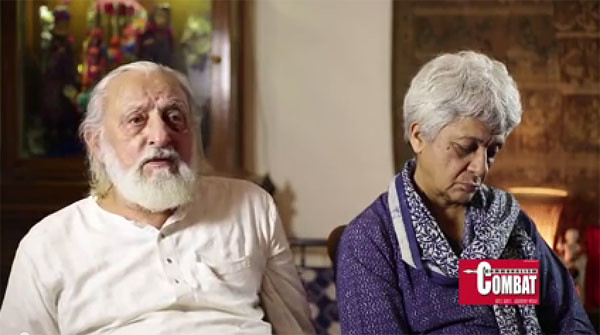By TCN News,
Mumbai: Films like Garm Hawa that offer a unique perspective on partition are of particular relevance today, given the current Indian regime that is characterised by a communal and fundamentalist outlook, noted film director MS Sathyu told Teesta Setalvad in this week’s special interview of Communalism Combat on Hilletv and Sabrang.com.
his interview is one of a series Audio-Visual interviews, jointly produced by Communalism Combat (www.sabrang.com) and www.hillele.org
Speaking on the occasion of the re-release of the award winning film, Garm Haw that showcased the trauma and violence of partition through the plight of those Muslims who opted to stay behind, Sathyu spoke at length along with colleague and fellow traveller Shama Zaidi who is also the co-scriptwriter of the film.
Garm Hawa, that was denied film certification for several months, given the intemperate objections from extreme right-wing forces like the Shiv Sena that held up the release, went on to win national and international acclaim. Sathyu also won the Nargis Dutt Award for Best Feature Film on National Integration for the film as also the Filmfare Awards for both Best Film and Best Director.
Questions on the ‘nationalism’ and ‘patriotism’ of Indian Muslims, the attendant discrimination in access to livelihood and enforced ghettoization and segregation echo through the powerful depiction, showcasing present day realities for Indian minorities that have in no way lessoned, 67 years after Independence and Partition. Salim Mirza (played by Balraj Sahni who died the day after the last day of dubbing for the film was complete) says with conviction, ”Gandhiki ki shahadat ke baad koi khoon kharaba nahin hoga”, words that mock the reality that is today.
The interview traverses interesting biographical details including the emergence of the final script after the seed of the story was fashioned by Ismat Chugtai well known writer. It was Rajinder Singh Bedi who told Zaidi that the narrative of Muslims who chose to stay behind after partition needed to be depicted on celluloid and that Sathyu should be the director who undertook this huge task. Kaifi Azmi re-fashioned Chugtai’s version into the epic political narrative that has Shama Zaidi’s unique touch as a writer.
The entire Garm Hawa team, led by this intrepid duo refused to succumb to the pressures of Bal Thackeray that held up the film’s release in 1974 till he whetted and saw the film. Finally the film was released after he viewed it minus the team being present! Jansangh leader, LK Advani had in an irresponsible comment over the controversy around the film, said, without even seeing the film, that it must have been funded by Pakistan! How could political leaders be so irresponsible, asked Sathyu in this interview?
Many of the creative team involved in the making of the film, were part of the Indian People’s Theatre Association (IPTA) and its making a unique reflection of the contribution of the left movement to Indian culture, especially cinema. The film was shot on location over 40-45 days in Agra. Over decades, until the late 1970s, several senior members of the communist party actually turned to cinema as a means of mass communication.
Made on a shoestring budget released by NFDC, Sathyu meticulously paid back the principle with interest over several decades that he had initially taken for the making of Garm Hawa. He even paid the cast like Farooq Shaikh and Balraj Sahni small amounts over a period of time. “Farooq saab was paid Rs 750 and Balraj Sahni a total of five thousand rupees, that too after his death,” said Sathyu.

Cinema in India is not a medium for serious reflection or meditation, which is why we have few films on the national movement and barely five or six on partition, opined Zaidi in the interview. Even the more realistic films like the epic ones made by Satyajit Ray depicted everyday life and bitter realities, not historical episodes and periods.
Today Hindi cinema, except for a handful of films, is completely disconnected from the realities of Indian life unlike the cinema in other languages, said Zaidi. While the access to technology had provided a veneer to Indian society we are still steeped in the 1800s resulting in the crude, Amar Chitra Katha kind of Hinduism, typified by the political regime.

